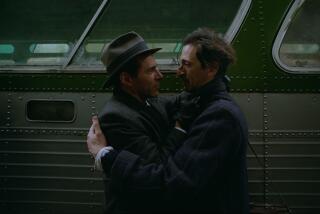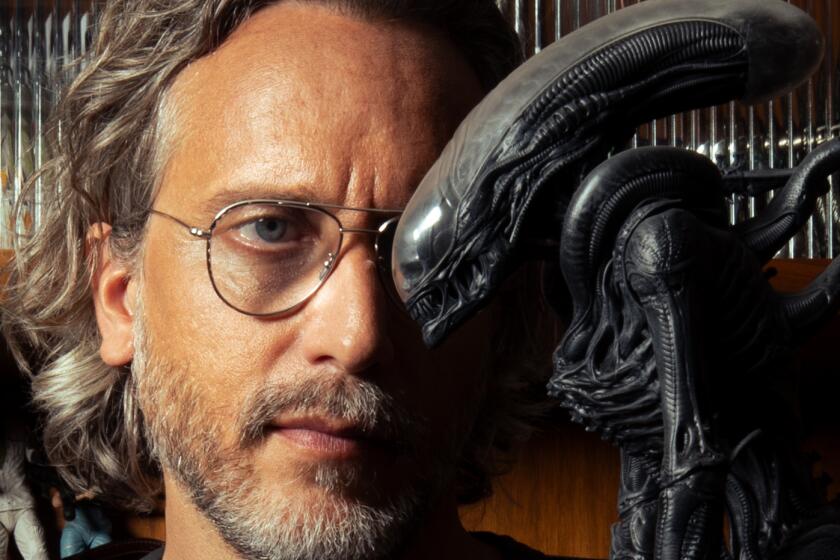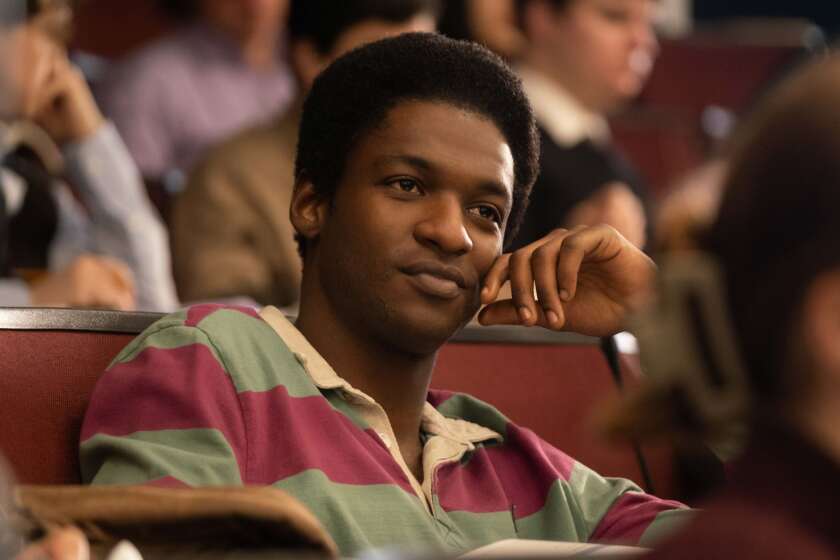Alfonso Cuarón delves into his childhood for ‘Roma’ and already talk turns to Oscars
Over the course of his filmmaking career, Alfonso Cuarón has explored everything from outer space (“Gravity”) to a dystopian future (“Children of Men”) to a world populated by wizards and fantastical creatures (“Harry Potter and the Prisoner of Azkaban”).
With his newest film, the 56-year-old director is somewhere that’s closer to home but no less rich in mystery or magic: his own past.
Set in Mexico City in the early 1970s and inspired by his childhood memories, Cuarón’s upcoming drama “Roma” follows a year in the life of a middle-class family and its nanny, Cleo, chronicling the dramas, small and large, that at times fray their relationships and the love that binds them together.
Shot in black and white, with a cast mixing professional actors and non-actors and a scope at once intimate and epic, “Roma” received rapturous reviews in its initial outings at the Venice and Telluride film festivals for its blend of naturalism and poetry, and its sensitive handling of difficult issues of class and race. Even as the film is set to screen at the Toronto International Film Festival on Monday, many are already predicting it could bring Netflix, which will release it theatrically and via streaming in December, its first best picture nomination.
On a drizzly Sunday afternoon, in between screenings at the Telluride Film Festival, Cuarón and the film’s two lead actresses — Yalitza Aparicio, who plays Cleo, and Marina de Tavira, who plays the family matriarch — sat in a house on a side street in the scenic Colorado town, clearly still processing the early acclaim the movie has received.
“This film only works because of the two of them,” Cuarón said, beaming at the women who form the emotional core of “Roma.”
FULL COVERAGE: Toronto Film Festival 2018 »
For 24-year-old Aparicio — who hails from a town in Oaxaca, has never acted before and speaks no English — traveling with the film to Venice and now Telluride has been a particularly dizzying experience. “This has been incredible,” she said, speaking through a translator. “It’s so beautiful to be able to go to all these places. I wasn’t expecting this result. Many people told me, ‘Sometimes you film something and in the end it never even comes out.’ ”
For 10 years, Cuarón had mulled the idea of a film about his childhood in the Roma neighborhood of Mexico City that would center on his beloved nanny, Libo, who was like a second mother to him. But, even as he tackled ever more ambitious Hollywood films, becoming the first Mexican to win the director Oscar for 2013’s “Gravity,” he found the prospect of mining his memories on screen daunting.
“I think that I didn’t have the emotional tools to do the film,” said Cuarón, who had not made a film in Mexico since 2001’s “Y Tu Mamá También.” “I guess that I had to age a little bit more to have a different understanding of my own life, you know? It was a matter of coming to terms with the conflict between my present and the past. Because in the process there was a constant tension: I’m trying to portray those memories but through the prism of my understanding of today.”
Two and a half years ago, finally feeling ready to tackle the project, Cuarón pitched the idea for “Roma” to Participant Media, which agreed to partner with him on the film’s production.
“I felt that the story Alfonso was telling was something that actually resonated with me even though I grew up in Eugene, Ore.,” said Participant Chief Executive David Linde, who is an executive producer on “Roma.” “It felt very personal but also very timely at the moment. At Participant, we really believe in inspirational storytelling, and to me the story of this woman and the family around her was about as inspirational as anything I had heard in a long time.”
As Cuarón worked on the script, he conducted extensive interviews with Libo to better understand what she had gone through all those years ago. Then he set about trying to find the right women to bring the film’s two central roles to life.
“It was a long, long, long process,” Cuarón said. “We met with thousands of women. Actors and non-actors — it didn’t matter. But they had to look just the same as the characters in real life and also have the same qualities.”
Cuarón was already familiar with De Tavira from her work in Mexican films and TV series. But to find someone to play Cleo, who is from a rural indigenous background, the film’s casting team traveled far outside Mexico City to towns and villages in the southern state of Oaxaca. There, in the community of Tlaxiaco, they found Aparicio, who received a bachelor’s degree in preschool education and had never before considered acting.
“My sister forced me to get into the casting because she wanted to know what it was all about,” said Aparicio. “She said, ‘Go and tell me about it.’ ” At first, her parents resisted the idea of her traveling to the capital city of Oaxaca for the initial casting session. “They thought it could be some kind of human trafficking,” she said.
Eventually, Aparicio’s mother agreed to accompany her to Oaxaca and then to Mexico City, where she met with Cuarón. She had no real idea who he was — an advantage, she says, that helped ease her nerves. “From the very beginning, he talked as if we had met a long time ago,” Aparicio said. “Other girls knew already he was a master director, but I had read very little about it. So I took it easier, I think, because of that.”
With the cast in place, Cuarón made the unorthodox decision to keep the script to himself and shoot the film chronologically, telling the actors only what they needed to know to get through each day’s scenes with a mix of scripted dialogue and improvisation.
Every day we got to the set, we didn’t know what was going to happen. That was really challenging.
— Marina de Tavira
“I think that was a great gift that he gave us,” De Tavira said. “Because we had to discover their life as we discover it in our own lives. Every day we got to the set, we didn’t know what was going to happen. That was really challenging, but it gave the scenes something that feels like the spirit of life.”
Cuarón and his production team painstakingly re-created his childhood home down to the smallest detail, recovering 70% of the original furniture from various family members.
“The first time my mother and Libo visited the set, they were in shock,” said the director. The two watched as Cuarón and his cast filmed an emotional scene in which the mother informs her four children that their father, a doctor who has become increasingly absent from the family, won’t be home for Christmas.
“After a few takes, I went to check on them and Libo was crying and crying,” said Cuarón, who showed his mother an early cut of the film before she passed away earlier this year. “I went to hug her and said, ‘Is this making you feel uncomfortable?’ She said, ‘No, I’m just crying because of the poor kids, how much they must have suffered.’ ”
One of several highly anticipated movies Netflix is releasing this fall — including the Coen brothers’ western anthology film “The Ballad of Buster Scruggs” and Paul Greengrass’ Norway-terror-attack drama “22 July” — “Roma” will be closely watched by many in the industry for how robust a theatrical push the streaming service decides to give it. According to a recent story in the Hollywood Reporter, Netflix is mulling a possible exclusive theatrical run for the film, which would mark a major break in precedent for the company. A Netflix representative declined to comment on the report.
While Netflix has made significant inroads with filmmakers and film festival programmers in the past couple of years, some remain wary of its day-and-date release model — in which a film is available in theaters and streaming at the same time — as evidenced by its standoff with the Cannes Film Festival earlier this year, fearing it poses an existential threat to traditional film distribution.
For his part, Cuarón says Netflix has been nothing but supportive since it came on board to distribute the film.
“Yes, the whole idea is trying to get not only a theatrical release but the best theaters possible,” he said. “The ideal theaters would be with HDR Dolby projections and with Atmos sound because that’s the ultimate experience to watch the film. But by the same token, if people choose to see it somewhere else, what can I do?
“You have to think also of the longevity of your films,” he continued. “The theatrical release is obviously the ultimate way to see your film, but also you want to have a very clear and present life in whichever form it’s going to live for the rest of its days. When is the last time you saw a Bresson film on the big screen? That’s the reality that we live. Of course, I’m a big defender of the big screen. The film was made for the big screen. But I’m also a big defender of options.”
Perhaps the most gratifying thing about the early response to “Roma,” Cuarón said, is that — in an era of rising anti-immigrant sentiment and pervasive fears of the “other” — this story about the life of a Mexican domestic worker and the family around her seems to be resonating with people from all kinds of backgrounds.
“You just trust that if you feel strongly about something, people are going to relate to it,” he said. “We have cultural differences, and, yes, Mexican audiences are probably going to see even more detail in the film in terms of the cultural idiosyncrasies and the political dynamics. But thematically, we are all the same. I mean, people are people.”
Twitter: @joshrottenberg
More to Read
Only good movies
Get the Indie Focus newsletter, Mark Olsen's weekly guide to the world of cinema.
You may occasionally receive promotional content from the Los Angeles Times.











